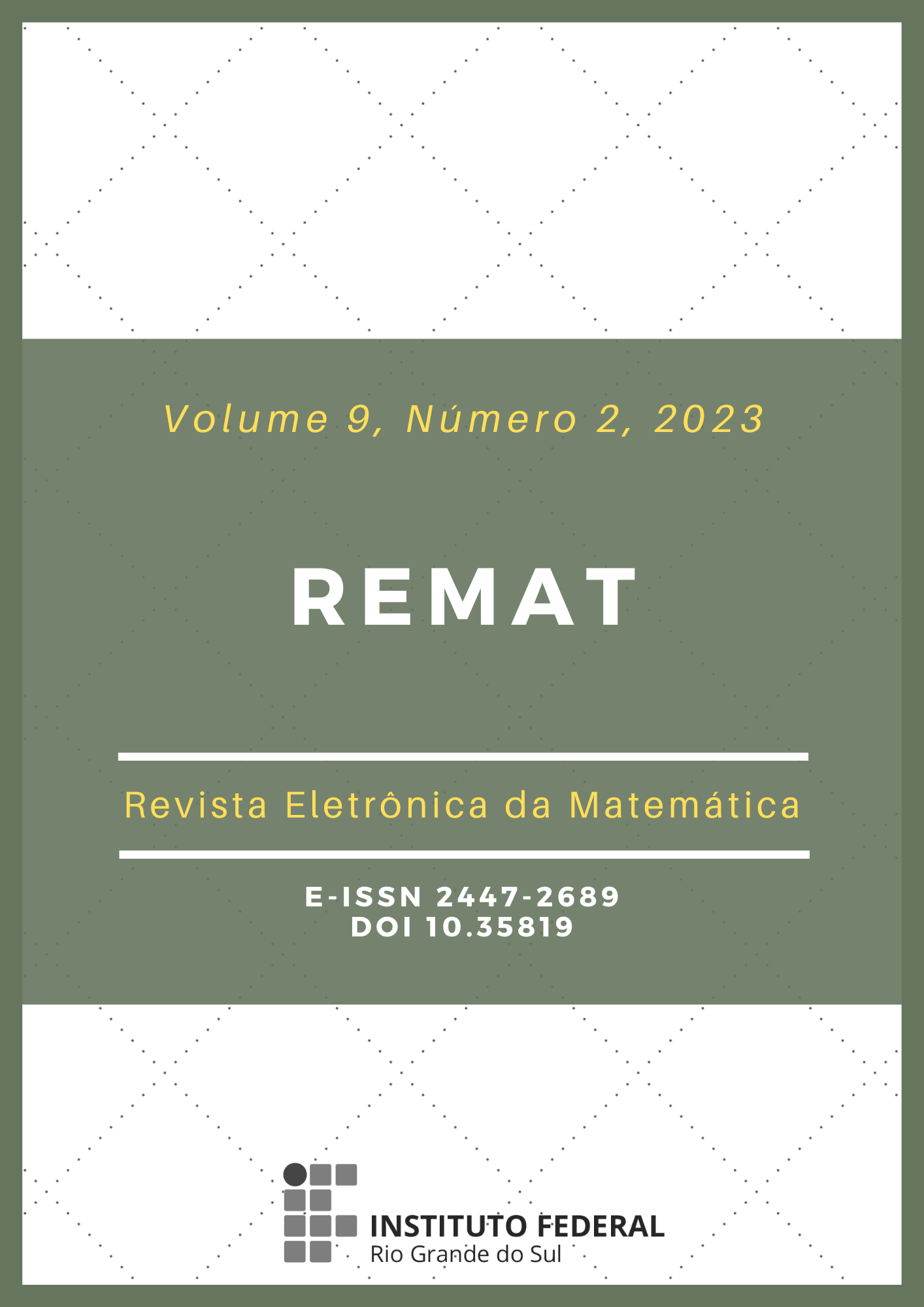Uma estratégia Filtro-SQP para treinamento de modelos de Máquina de Vetores de Suporte
DOI:
https://doi.org/10.35819/remat2023v9i2id6241Palavras-chave:
máquina de vetores de suporte, treinamento, otimização, método de filtro, programação quadrática sequencialResumo
Neste artigo, introduzimos uma estratégia de Filtro para resolver o problema de otimização decorrente da do método de classificação Máquina de Vetores de Suporte. Este problema de treinamento visa resolver a formulação dual, que envolve uma função objetiva quadrática sujeita a uma restrição lineares de igualdade e caixa. Esta abordagem aplica um algoritmo de Filtro com iterações de Programação Quadrática Sequencial, que minimizam as aproximações Lagrangiano quadráticas, usando a matriz Hessiana exata nos experimentos numéricos, em busca da função de classificação desejada. Apresenta-se um algoritmo de Filtro combinado com o método do Lagrangiano Aumentado visando acelerar a convergência do algoritmo. Também apresentamos resultados numéricos obtidos ao implementar nosso algoritmo proposto no MATLAB e comparar os resultados com outras metodologias da literatura. Os experimentos numéricos mostram que o método de Filtro-SQP combinado com o método do Lagrangiano Aumentado é um método competitivo e eficiente em relação às métricas de classificação e tempo de CPU, em comparação com um solucionador baseado em Pontos Interiores e o software LIBSVM.
Downloads
Referências
BALDI, P. ; BRUNAK, S.; CHAUVIN, Y.; ANDERSEN, C.; A. F.; NIELSEN, H. Assessing the accuracy of prediction algorithms for classification: an overview. Bioinformatics, v. 16, n. 5, p. 412-424, 2000. DOI: https://doi.org/10.1093/bioinformatics/16.5.412.
BISHOP, C. M. Pattern recognition and machine learning. [S.l.]: Springer, 2006.
BOSER, B. E.; GUYON, I. M.; VAPNIK, V. N. A training algorithm for optimal margin classifiers. In: FIFTH ANNUAL WORKSHOP ON COMPUTATIONAL LEARNING THEORY, Pittsburgh, Pennsylvania, USA, 1992. Proceedings [...]. New York, NY, USA: Association for Computing Machinery, 1992, p. 144-152. DOI: https://doi.org/10.1145/130385.130401.
CHANG, C.-C.; LIN, C.-J. LIBSVM: A Library for Support Vector Machines. ACM Transactions on Intelligent Systems and Technology, v. 2, n. 3, p. 1-27, 2011. DOI: https://doi.org/10.1145/1961189.1961199.
CHAUHAN, V. K.; DAHIYA, K.; SHARMA, A. Problem formulations and solvers in linear SVM: a review. Artificial Intelligence Review, v. 52, n. 2, p. 803-855, 2019. DOI: https://doi.org/10.1007/s10462-018-9614-6.
CHEN, H. L.; YANG, B.; WANG, S. J.; Wang, G.; LIU, D. Y.; LI, H. Z.; LIU, W. B. Towards an optimal support vector machine classifier using a parallel particle swarm optimization strategy. Applied Mathematics and Computation, v. 239, p. 180-197, 2014. DOI: https://doi.org/10.1016/j.amc.2014.04.039.
CORTES, C.; VAPNIK, V. Support-vector networks. Machine Learning, v. 20, p. 273-297, 1995. DOI: https://doi.org/10.1007/BF00994018.
CRISTIANINI, N.; SHAWE-TAYLOR, J. An introduction to support vector machines and other kernel-based learning methods. [S.l.]: Cambridge University Press, 2000. DOI: https://doi.org/10.1017/CBO9780511801389.
DENG, N.; TIAN, Y.; ZHANG, C. Support Vector Machines: Optimization based theory, algorithms, and extensions. [S.l.]: Chapman & Hall, CRC Press, 2012.
DOLAN, E. D; MORÉ, J. J. Benchmarking optimization software with performance profiles. Mathematical Programming, v. 91, p. 201-213, 2002. DOI: https://doi.org/10.1007/s101070100263.
FAN, R.-E.; CHANG, K.-W.; HSIEH, C.-J.; WANG, X.-R.; LIN, C-J. Liblinear: A library for large linear classification. Journal of Machine Learning Research, v. 9, p. 1871-1874, 2008.
FERRIS, M. C.; MUNSON, T. S. Interior-point methods for massive support vector machines. SIAM Journal on Optimization, v. 13, n. 3, p. 783-804, 2002. DOI: https://doi.org/10.1137/S1052623400374379.
FLETCHER, R.; LEYFFER, S. Nonlinear programming without a penalty function. Mathematical Programming, v. 91, p. 239-269, 2002. DOI: https://doi.org/10.1007/s101070100244.
FROHLICH, H.; ZELL, A. Efficient parameter selection for support vector machines in classification and regression via model-based global optimization. In: IEEE INTERNATIONAL JOINT CONFERENCE ON NEURAL NETWORKS, Montreal, QC, Canada, 2005. Proceedings [...]. v. 3, 2005, p. 1431-1436. DOI: https://doi.org/10.1109/IJCNN.2005.1556085.
GONZAGA, C. C.; KARAS, E.; VANTI, M. A globally convergent filter method for nonlinear programming. SIAM Journal on Optimization, v. 14, n. 3, p. 646-669, 2004. DOI: https://doi.org/10.1137/S1052623401399320.
GOULD, N. I. M.; LEYFFER, S.; TOINT, P. L. A multidimensional filter algorithm for nonlinear equations and nonlinear least-squares. SIAM Journal on Optimization, v. 15, n. 1, p. 17-38, 2004. DOI: https://doi.org/10.1137/S1052623403422637.
HASTIE, T.; TIBSHIRANI, R.; FRIEDMAN, J. The elements of statistical learning: data mining, inference, and prediction. Springer Series in Statistics. 2. ed. [S.l.]: Springer, 2009. DOI: https://doi.org/10.1007/978-0-387-84858-7.
HSIEH, C.-J.; CHANG, K.-W.; LIN, C.-J.; KEERTHI, S S.; SUNDARARAJAN, S. A dual coordinate descent method for large-scale linear SVM. In: 25TH INTERNATIONAL CONFERENCE ON MACHINE LEARNING, Helsinki, Finland, 2008. Proceedings [...]. New York, NY, USA: Association for Computing Machinery, 2008, p. 408-415. DOI: https://doi.org/10.1145/1390156.1390208.
IZMAILOV, A. F.; SOLODOV, M. V. Newton-type methods for optimization and variational problems. Springer Series in Operations Research and Financial Engineering. [S.l.]: Springer, 2014. DOI: https://doi.org/10.1007/978-3-319-04247-3.
JOACHIMS, T. Making large-scale SVM learning practical. [S.l.]: [S.n.], 1998, p. 41-56.
JOACHIMS, T. Training linear SVMs in linear time. In: 12TH ACM SIGKDD INTERNATIONAL CONFERENCE ON KNOWLEDGE DISCOVERY AND DATA MINING, Philadelphia, PA, USA, 2006. Proceedings [...]. New York, NY, USA: Association for Computing Machinery, 2006, p. 217-226. DOI: https://doi.org/10.1145/1150402.1150429.
LIN, C.-J.; WENG, R. C.; KEERTHI, S. S. Trust region newton method for logistic regression. Journal of Machine Learning Research, v. 9, n. 22, p. 627-650, 2008. Available in: https://www.jmlr.org/papers/v9/lin08b.html. Access at: October 29, 2023.
MANGASARIAN, O. L.; MUSICANT, D. R. Lagrangian support vector machines. Journal of Machine Learning Research, v. 1, n. 3, p. 161-177, 2001.
MATTHEWS, B. W. Comparison of the predicted and observed secondary structure of T4 phage lysozyme. Biochimica et Biophysica Acta (BBA) - Protein Structure, v. 405, n. 2, p. 442-451, 1975. DOI: https://doi.org/10.1016/0005-2795(75)90109-9.
NIU, D.; WANG, C.; TANG, P.; WANG, Q.; SONG, E. A sparse semismooth Newton based augmented Lagrangian method for large-scale support vector machines. arXiv:1910.01312, 2019. DOI: https://doi.org/10.48550/arXiv.1910.01312.
NOCEDAL, J.; WRIGHT, S. Numerical optimization. Springer Series in Operations Research and Financial Engineering. 2. ed. [S.l.]: Springer, 2006. DOI: https://doi.org/10.1007/978-0-387-40065-5.
PERIÇARO, G. A.; RIBEIRO, A. A.; KARAS, E. W. Global convergence of a general filter algorithm based on an efficiency condition of the step. Applied Mathematics and Computation, v. 219, n. 17, p. 9581-9597, 2013. DOI: https://doi.org/10.1016/j.amc.2013.03.012.
PICCIALLI, V.; SCIANDRONE, M. Nonlinear optimization and support vector machines. 4OR, v. 16, p. 111-149, 2018. DOI: https://doi.org/10.1007/s10288-018-0378-2.
PLATT, J. Sequential minimal optimization: A fast algorithm for training support vector machines. [S.l.]: Microsoft, 1998. Available in: https://www.microsoft.com/en-us/research/publication/sequential-minimal-optimization-a-fast-algorithm-for-training-support-vector-machines. Access at: October 29, 2023.
SCHÖLKOPF, B.; SMOLA, A. J. Learning with kernels: support vector machines, regularization, optimization, and beyond. [S.l.]: MIT Press, 2001.
SMOLA, A. J.; VISHWANATHAN, S. V. N.; LE, Q. V. Bundle methods for machine learning. In: TWENTY-FIRST ANNUAL CONFERENCE ON NEURAL INFORMATION PROCESSING SYSTEMS, Vancouver, British Columbia, Canada, 2007. Proceedings [...]. [S.l.]: Curran Associates, 2007, p. 1377-1384. Available in: https://proceedings.neurips.cc/paper_files/paper/2007/file/26337353b7962f533d78c762373b3318-Paper.pdf. Access at: October 1, 2023.
SHALEV-SHWARTZ, S.; Singer, Y.; Srebro, N.; Cotter, A. Pegasos: primal estimated sub-gradient solver for SVM. Mathematical Programming, v. 127, p. 3-30, 2011. DOI: https://doi.org/10.1007/s10107-010-0420-4.
SHAWE-TAYLOR, J.; CRISTIANINI, N. Kernel methods for pattern analysis. [S.l.]: Cambridge University Press, 2004.
TORREALBA, E. M. R.; SILVA, J. G.; MATIOLI, L. C.; KOLOSSOSKI, O.; SANTOS, P. S. M. Augmented Lagrangian algorithms for solving the continuous nonlinear resource allocation problem. European Journal of Operational Research, v. 299, n. 1, p. 46-59, 2022. DOI: https://doi.org/10.1016/j.ejor.2021.11.027.
WOODSEND, K.; GONDZIO, J. Exploiting separability in large-scale linear support vector machine training. Computational Optimization and Applications, v. 49, p. 241-269, 2011. DOI: https://doi.org/10.1007/s10589-009-9296-8.
WOODSEND, K.; GONDZIO, J. Hybrid mpi/openmp parallel linear support vector machine training. Journal of Machine Learning Research, v. 10, p. 1937-1953, 2009.
YAN, Y.; LI, Q. An efficient augmented lagrangian method for support vector machine. Optimization Methods and Software, v. 35, n. 4, p. 855-883, 2020. DOI: https://doi.org/10.1080/10556788.2020.1734002.
YIN, J.; LI, Q. A semismooth newton method for support vector classification and regression. Computational Optimization and Applications, v. 73, p. 477-508, 2019. DOI: https://doi.org/10.1007/s10589-019-00075-z.
Downloads
Publicado
Edição
Seção
Licença
Copyright (c) 2023 REMAT: Revista Eletrônica da Matemática

Este trabalho está licenciado sob uma licença Creative Commons Attribution 4.0 International License.
Os autores detêm os direitos autorais dos artigos publicados e concedem à REMAT o direito de primeira publicação e distribuição de partes ou do trabalho como um todo com o objetivo de promover a revista. Os autores são autorizados a distribuir a versão publicada do artigo, como por exemplo em repositórios institucionais, desde que façam menção de publicação inicial nesta revista a partir da disponibilização do DOI do artigo.
Os artigos são publicados sob a licença Creative Commons Attribution 4.0 International License (CC BY 4.0). Isso permite que o conteúdo seja utilizado para criação de novos trabalhos, tanto para fins comerciais quanto não comerciais, desde que seja feita a devida atribuição ao autor original, conforme especificado na licença.













 https://orcid.org/0000-0002-0893-7426
https://orcid.org/0000-0002-0893-7426


















